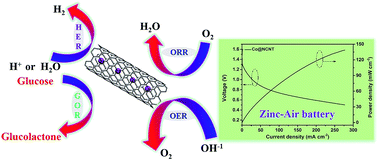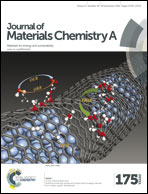Multifunctional high-activity and robust electrocatalyst derived from metal–organic frameworks†
Abstract
High-activity electrocatalysts with robust structure are critical for development of renewable-energy technologies. Herein, a hybrid of cobalt nanoparticles embedded in N-doped carbon nanotubes (Co@NCNT) was fabricated via economically scalable pyrolysis of a mixture of a Co-based metal–organic framework (ZIF-67) and dicyandiamide. The as-synthesized Co@NCNT hybrid was characterized by techniques of scanning electron microscopy (SEM), transmission electron microscopy (TEM), and X-ray photon spectroscopy (XPS) etc., confirming that it possessed desirable properties of high surface area, robust structure, and good conductivity. A series of electrochemical measurements demonstrated that the Co@NCNT exhibits high activity and excellent durability toward several important electrochemical reactions, including hydrogen evolution reaction (HER) in pH-universal electrolyte, oxygen reduction reaction (ORR) in both acidic and alkaline media, glucose oxidation reaction (GOR), and oxygen evolution reaction (OER) in alkaline medium, mainly as a result of the synergistic effects of unique structure and high surface area of the Co nanoparticles and nitrogen dopant in the nanocomposite. A zinc–air battery with outstanding performance was set up using the Co@NCNT as cathode material, demonstrating its potential applications in energy storage and as a conversion system device.


 Please wait while we load your content...
Please wait while we load your content...